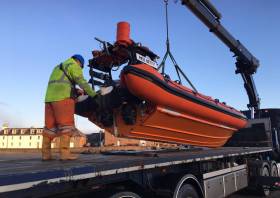Displaying items by tag: Stonehaven
Pagers sounded for Largs RNLI’s volunteers yesterday afternoon (Thursday 27 May) after reports over VHF radio of a vessel on fire off Inverkip, on the Firth of Clyde in western Scotland.
The inshore lifeboat made best speed to the scene shortly after the 2.15pm alert, and on arrival learned that another boat had taken the crew from the casually vessel had them in tow to nearby Inverkip Marina.
It was established the crew of the casualty vessel had extinguished the fire and as the danger was now over, with no injuries reported, the lifeboat returned to station.
Much earlier yesterday, off Scoland’s east coast, Stonehaven RNLI launched the aid of a sailing vessel with engine problems.
The vessel was heading north under sail and had reached Dunnottar Castle, just south of Stonehaven, when the wind dropped at around 1am. Attempts were made to start the engine, but these were not successful.
 The crew of the inshore lifeboat Jamie Hunter escort a sailing vessel with engine trouble into Stonehaven Harbour | Credit: RNLI
The crew of the inshore lifeboat Jamie Hunter escort a sailing vessel with engine trouble into Stonehaven Harbour | Credit: RNLI
As concerns grew that the tide might pull the boat towards the rocky coast, the UK Coastguard called out the station’s inshore lifeboat Jamie Hunter, which was launched at 4am.
After reaching the vessel and confirming its two crew members were safe and well, Largs RNLI put mechanic Paul Sim on board to assess the situation and he was able to get limited power from the engine — which allowed the vessel to be escorted into Stonehaven Harbour just after 7am.
Speaking just after the callout, lifeboat helm Andy Martin said: “It was certainly an early morning pager call for our volunteer crew, and they quickly got to the scene.
“It had the potential to become quite dangerous for the sailing vessel, but Paul’s mechanical experience and expertise came in very handy.
“We are pleased to have been able to help and the situation worked out with everyone recovered safe and well.”
In other lifeboat news from Scotland, Tobermory RNLI launched on Wednesday (26 May) following a report of a semi-submerged kayak with a dry bag in Sanna Bay, Ardnamurchan.
 File image of Tobermory RNLI’s Severn Class lifeboat | Credit: RNLI/Sam Jones
File image of Tobermory RNLI’s Severn Class lifeboat | Credit: RNLI/Sam Jones
Stornoway Coastguard confirmed that the kayak had been reported to have been washed out to sea from Loch Scavaig on the Isle of Skye and that there were no missing persons.
The lifeboat crew recovered the kayak and dry bag and transported them to Kilchoan where they were left in the care of the local Coastguard Rescue Team.
The shout came six days after a callout to a yacht which had lost its drive in the Sound of Mull last Thursday evening, 20 May. The lifeboat met the yacht at the entrance to Tobermory Bay and, using an alongside tow, assisted it to berth at the harbour pontoons.
Tobermory RNLI station coxswain David McHaffie said: “In both of these incidents, the people involved made the correct call and contacted the coastguard so that we were able to respond in good time. We would much rather be called out too early than too late.”
It was a sad day this week as Stonehaven RNLI said goodbye to the last Atlantic 75 lifeboat in service in Scotland.
The volunteer crew in Aberdeenshire watched as Miss Berry was winched out of the water to be transported to Poole.
A brand new Atlantic 85, Jamie Hunter, is due to arrive on station in the next few weeks. At the moment the crew are training hard on a relief Atlantic 85.
The new lifeboat has some advancement on its predecessor. The Atlantic 85 design allows room for four crew members and more kit than the Atlantic 75 lifeboat, which only had room for three crew.
It is powered by two 115hp engines and has a stronger hull and greater top speed of 35 knots. The added radar allows the crew to operate more effectively in poor visibility and there is also VHF direction-finding equipment.
The Atlantic 85, which was introduced to the RNLI fleet in 2005, also carries a full suite of communication and electronic navigation aids, as well as a searchlight, night-vision equipment and flares for night-time operations.
Stonehaven lifeboat operations manager Andy Martin said: “We are all sorry to say goodbye to Miss Betty. The Atlantic 75 has been a great lifeboat and kept many people safe, but we are proud to be the custodians of this new lifeboat that will allow our volunteers to save many more lives in the years to come.”





























































